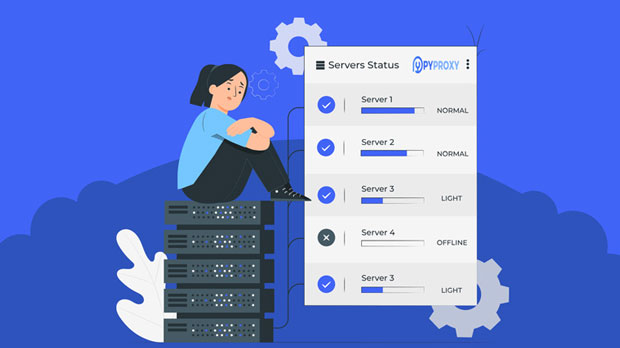How to choose the right server proxy IP service provider for you?
Choosing the right proxy server IP service provider is crucial for ensuring privacy, security, and performance in online activities. With a wide range of providers available, it can be overwhelming to determine which one best suits your specific requirements. Whether you're looking to bypass geo-restrictions, enhance security, or ensure smooth browsing, understanding the key factors to consider can help you make an informed decision. This article will explore the most important considerations when selecting a proxy server IP provider and how each factor can impact your overall experience. 1. Identify Your Primary Purpose and NeedsBefore diving into the vast sea of proxy providers, it’s essential to first identify your specific needs. Proxy services serve various purposes, such as improving online privacy, accessing geo-blocked content, managing multiple social media accounts, or ensuring safe browsing in sensitive industries. Each use case demands a different type of proxy. Therefore, understanding the primary purpose of using a proxy service is crucial to selecting the right provider.For example, if privacy is your main concern, you should prioritize services that offer robust encryption, no logging policies, and secure data transmission. On the other hand, if you need to access region-restricted content, you would need a provider with a large number of proxies spread across different locations. Clearly defining your objectives will narrow down the options and guide you toward the right choice.2. Types of Proxy Services AvailableThere are several types of proxy services available, each catering to different needs and offering distinct benefits. Understanding the differences is vital for selecting the one that aligns with your requirements.- residential proxies: These proxies are assigned to real devices and are ideal for activities like web scraping, bypassing geo-restrictions, or accessing content as if you were in a specific region. They are considered more reliable because they are less likely to be flagged or blocked by websites. - Datacenter Proxies: These are fast and widely used for tasks that demand high-speed internet access, such as browsing, social media management, or automated testing. However, they are more likely to be detected and blocked because they are not associated with real user IPs.- Mobile Proxies: These proxies use IP addresses from mobile networks and are ideal for accessing mobile-specific content or simulating user behavior on mobile devices.- SOCKS Proxies: SOCKS proxies are highly versatile and support a wide range of protocols, making them ideal for tasks requiring more control over data transfer, such as gaming, video streaming, or using specific applications.Understanding these different types of proxies will help you decide which one is best suited for your specific needs and goals.3. Location and Global CoverageThe location of the proxy servers is a critical factor to consider, especially if you need to access region-locked content or target specific geographic locations for web scraping. A provider with a wide range of IP addresses across different countries offers flexibility and ensures that you can obtain a local IP address wherever necessary.For example, if you're attempting to access content exclusive to a particular country, having a provider with proxy servers in that region will increase the likelihood of successful access. Additionally, the more diverse the proxy locations, the better the coverage and flexibility when dealing with geo-restricted content.4. Speed and PerformanceProxy speed is an important consideration, especially if you're using proxies for tasks that require high-speed internet, such as gaming, video streaming, or web scraping. Slow proxies can lead to frustrating delays, reduced productivity, and poor user experience.When choosing a provider, inquire about the bandwidth offered by their proxy servers and the typical speed you can expect under normal conditions. It's also worth considering the provider's network infrastructure, as a high-quality provider will have robust data centers and an optimized network to ensure fast, reliable connections.5. Security FeaturesSecurity is one of the most critical factors when selecting a proxy service, particularly for sensitive online activities. Proxies can help enhance privacy by masking your real IP address, but without adequate security measures, they may expose you to various risks, such as data leaks or interception.Ensure that the proxy provider you choose offers secure encryption protocols (such as HTTPS or SOCKS5), which protect your data during transmission. A provider with a strict no-logs policy is also essential to ensure that your browsing activity is not recorded or tracked. Additionally, advanced security features like IP rotation, anonymous browsing, and anti-fingerprint protection can further enhance your online security.6. Customer Support and Service ReliabilityReliable customer support is a key consideration when choosing a proxy service provider. While you may not need support often, having access to responsive and knowledgeable customer service can be a lifesaver in case you encounter issues with your service.Look for providers that offer 24/7 customer support through various channels, such as live chat, email, or phone. The quality of customer service is an important indicator of the provider's professionalism and their willingness to help you resolve any problems quickly. Additionally, ensure that the provider has a strong reputation for uptime and minimal service disruptions.7. Pricing and Payment PlansPrice is an obvious factor when selecting a proxy service provider, but it's essential to balance cost with the quality of service offered. Some providers offer budget-friendly plans that may lack advanced features or reliability, while others may offer premium services at higher prices.Evaluate the pricing structure to ensure it aligns with your budget and needs. Some providers offer flexible payment plans, such as pay-as-you-go or subscription-based models, so choose the one that fits your usage pattern. Additionally, consider any extra costs for additional features like dedicated IPs, enhanced security options, or premium support services.8. User Reviews and ReputationFinally, researching user reviews and feedback from other customers can provide valuable insights into the quality and reliability of a proxy service provider. Look for reviews on independent forums, review websites, or social media platforms to understand the experiences of other users.While not all reviews may be completely objective, a provider with a solid reputation and positive feedback from users is more likely to offer a reliable and high-quality service. Pay attention to any consistent complaints or issues raised by users, especially regarding performance, security, or customer support.ConclusionChoosing the right proxy server IP service provider is essential for achieving your online goals, whether it's for privacy, performance, or geo-restriction bypass. By carefully considering factors such as your specific needs, types of proxies, location coverage, speed, security, support, pricing, and reviews, you can select the provider that best meets your requirements. Keep in mind that there is no one-size-fits-all solution, and the best choice depends on your unique use case. By taking the time to make an informed decision, you can enjoy a secure, reliable, and efficient proxy experience.
2025-01-23
























































